Three Reasons Why AAA Gaming Should Stop Worrying About Photo-Realistic Graphics
Graphics have always been a big part of gaming and visual fidelity has often been used to sell games to the mass market. However, in recent years the larger publishers and developers have become far too fixated on this aspect of making games. I will be offering three examples of why this obsession with photo-realistic graphics is ultimately misplaced, but first I want to summarise the current state of the AAA gaming industry and explain exactly why its current trajectory is harmful.
Emotionless Polygons
In February of this year Sony announced the PS4 and properly kicked off the next generation of console wars. During the show David Cage – head of Heavy Rain developer Quantic Dream – delivered a presentation about emotional connection and visual fidelity, handily encapsulating the issue at hand.
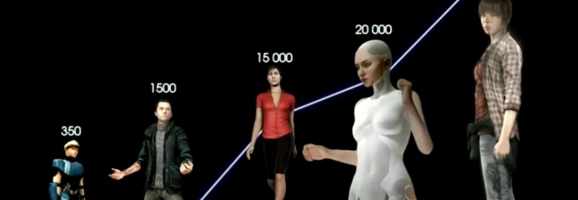
In his speech he talks about how the number of polygons used have increased with each game he makes. The implication is that more polygons are better: it’s progress. According to Cage characters with lower polygon counts cannot act as true reflections of humanity because their emotion cannot be properly displayed. He then shows us an old man’s head, without a body, floating in a black void. It’s completely isolated from any context; setting, story and history are completely absent. Yet Cage tells us that we “can see soul just looking into his eyes.”
The presumption that, just by looking realistic, a figure suddenly becomes a deep character, that through polygons we are told “who he is, what he thinks, what has happened to him”, is both ludicrous and insulting. In exactly the same way that Cage dismisses early cinema – apparently the limits of camerawork, lighting and sound meant that these films couldn’t properly engage the viewer – he also dismisses the work of developers who cannot afford to make games in which each character has thousands of polygons.
This isn’t to say that Cage is the only person with this attitude. During Microsoft’s console announcement they thought it was a good idea to devote a ridiculously long time to showing us how amazing dogs and soldier’s arms would look in the upcoming Call of Duty: Ghosts. The trend kept going at E3 and what audiences received was mainly old IP with graphical updates or stuff like Ryse: Son of Rome, offering audiences a more “cinematic” experience: gameplay in Ryse:SoR seems to mainly consist of button-mashing Quick-Time Events and rhythm based shielding if the playable demo is anything to go on.
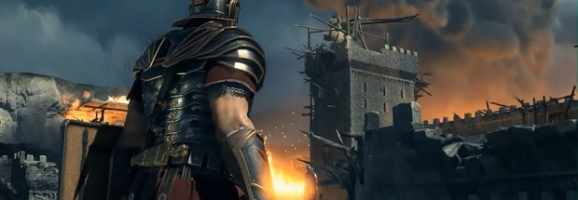
This attitude effectively boils down to one of style over substance. An attitude where developers are becoming much more concerned with how their games look than how they play, offering us stunning set pieces, life-like environments and highly rendered characters as the norm. Unfortunately the quality of games as games is suffering. Players are becoming pawns that the developer moves from set piece to set piece, our movements and actions restricted because we might not see expensive assets if, God forbid, we play it our own way.
It’s also causing a huge increase in the cost of development for big games companies. Hundreds of people are set to work creating new engines or developing new assets instead of actually working on the game itself and this practice means other companies feel they have to set the same standard, even on titles which may not need it. This attitude has contributed to the failing fortunes of companies like Square Enix and Capcom. Both have replaced their CEOs this year and both have been struggling to make their money back on flagship titles. Sqaure Enix’s Tomb Raider and Capcom’s Resident Evil 6 shifted millions of copies, but both were branded failures.
Why? Because the publishers threw huge amounts of money at them hoping that making them prettier and more epic would automatically make them best-sellers. Not only were these titles never going to be best-sellers – they seemed to expect Halo and CoD level sales- but the extra money spent on them didn’t even improve the quality of the game. Despite the huge cast and epic story, RE6 just played awfully and TR had too much expensive tat packed into it, the multiplayer was pointless and, although the TressFX hair engine looked great, I doubt anyone bought the game because of it.
This dogged focus on graphical fidelity stymies innovation too. Resources are funneled into visual effects, leaving only a small budget to actually work on the meat of the game. The whole process is so expensive that they’re too afraid to do anything interesting for fear of a flop: developers homogenize their games in an attempt to capture the widest possible audience. All this to sell enough copies just to make their money back. This catch all strategy just leads to unfocused messes that please nobody – just look at the myriad action-adventure-stealth-platformer-brawler-shooter titles out there that have slipped into anonymity because they just packed in mechanics from other, more popular, games.
This isn’t to say that you can’t have great games with stunning high-res graphics, you just have to look at the recent successes of The Last of Us and Bioshock Infinite for proof, but these games are noteworthy precisely because it’s so rare to get a AAA title with actual emotional depth, not just polygons pretending to be feelings.
Emotional Games
There is no point in highlighting an issue and giving no solution or alternative. Therefore I offer three games, developed by small companies with few resources that manage to connect with the player on an emotional level without resorting to Cage’s parameters.
One: Thomas Was Alone
How to counter the claim that emotional depth is directly proportional to polygon count? Oh that’s right, choose a game in which the entire cast consist of a single polygon each… and don’t speak… and are simple geometric shapes. Mike Bithell’s Thomas Was Alone presents us with a touching story of liberty, civil rights, love and sacrifice contained within an excellent platformer, masterfully narrated by Danny Wallace. You take control of a plethora of different characters, using their unique abilities to solve puzzles and making them work together in order to reach the end of each level.
Bithell complements the gameplay with a voice over, giving us insights into the thoughts of each of the shapes – which have names like Thomas, Sarah and Chris – as they accomplish each task. We see rivalries, friendships and love grow between the characters, whose personalities are as unique as their abilities.
The game demonstrates perfectly that soul does not spring from the detailed eyes of a photo-realistic old man. It shows us that a character doesn’t even need eyes for us to empathise with them, that, in order for us to feel emotion, we have to share in a character’s trials and tribulations and feel like what we’re doing matters.

Two: Bastion
Bastion is notable because, although it’s graphics are more advanced than those of Thomas Was Alone, it shows how character can come about through a compelling story and a well designed world. Now, well designed is very different from the type of graphics most AAA games possess. Bastion‘s presentation is bright, colourful and cartoony, a far cry from the flat browns and boring design of most blockbusters. It’s also gloriously beautiful, such that each screenshot is a work of art in and of itself.
Kid himself isn’t really developed, he’s not given the depth of characterisation that the cast of Thomas Was Alone has. However, the design, music and narration of the game come together to infuse everything you do with a sense of importance. You don’t care because anguish is picked out on Kid’s face in minute detail; you care because when you come across the ruins of a pub and the narrator mentions how wonderful it used to be, you fill in the blanks for yourself.
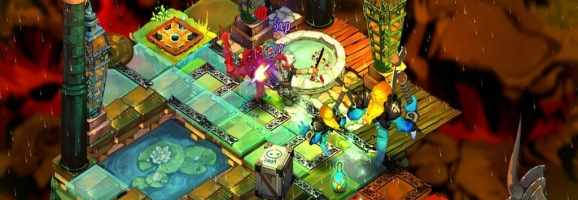
So I’ve showed you how emotional games can come about with characters who are developed either actively through their thoughts and feelings or passively through the world that they see, but how about a game that has no characters at all? With no characters to attach even one polygon to, how on earth can a player feel anything towards a game?
Three: Proteus
This choice may be controversial for a number of reasons – the biggest being the debate over whether it actually qualifies as a game at all. There are no discernible characters, you can’t do anything other than walk around and the whole thing has no definable goal. You just explore a randomly generated island and… observe. Yet the game can sooth you, brighten your mood and deeply move you. Despite the archaic graphics and simple chiptune music Proteus will connect with you far more than the majority of AAA titles on the market.
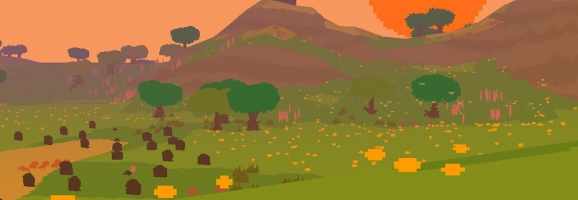
As you wander, the music changes depending on where you are – be it the woods, a mountain, or the sea – and creatures react to your approach. Everything gives off a sound and it all blends together to create a spell-binding atmosphere that will suck you right into the game. Its draw is that atmosphere; it has no characters because the only character in the game is you. All the game does is present this strangely beautiful island and leaves the rest up to you. The result: an incredibly personal experience that evokes a child-like wonder. An effect which is beyond all but a few really special works of art.
What do you think? Leave a comment.





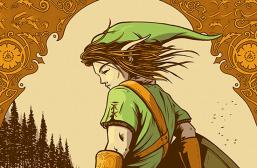


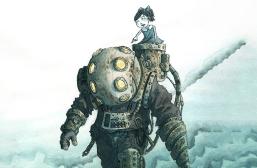


Very nice essay. You know I saw Thomas Was Alone at Rezzed in Brighton, got the demo on PC, then paid for it. Love the narration and humour and it builds to just enough of a challenge on the later levels, though as the review says perhaps peaks a little, and the challenge is more in working out how to get all the shapes through the level than jumping skils. Think that puzzle about getting the fox, the chicken and the corn across the river. Always had fun, and played with my 11 year old daughter taking turns. Just started again on PS3 being a + member, and coughed up the £2 for the DLC. However got completely stuck on this on the 3rd/4th level in a jet-packing spike negotiation part. Not sure if we’ll ever progress as the control needed to hover seems missing. Main game great though.
Yeah there’s only a few levels where your skill with jumping actually matters all that much, which I enjoy. More about brains than thumbs. Also lets you concentrate more on the narration and enjoy the story.
Didn’t realise there was any DLC though, I’ll have to go and check that one out!
I disagree with what you said about Proteus, I has characters! I saw a thing jumping about and honking, who ran away from me when ever I got close to it. Similar thing with some plants I saw. :-p
If you are talking about games, no, I don’t think Proteus counts. It’s art work. But for discussion about character and soul within games and by extension software, yes it counts. And that is what I think you are getting at in the article.
I hate games and game designers who think graphics = quality. Hell no! Gameplay = quality. You make a turd, it’s a turd, you make a pretty turd… it’s still a turd.
I certainly agree with the turd sentiment! Not so much with the Proteus. Those creatures aren’t really characters in the sense that I’m using the word. By character I mean an intelligence that you can identify with through either story or play. The plants and animals(?) that you come across are more part of the world, in the same way that if a rabbit hopped across my path in Fable I wouldn’t call it a character as it has a different function. Although mobile and technically sentient, it’s more part of the furniture from the perspective of game design.
Great article, I agree with you completely. I think it says a lot about why there’s been such a growth in demand for indie games recently.
Thanks! I agree, people are just getting fed up with big, boring games. It’s easier to make games now too, so happy that people can just have an idea and (albeit with a lot of effort) make a game out of it.
Great article dude!
Thanks, it’s always great to hear that people are enjoying the stuff I’m writing!
This topic has been on my mind a bit lately, particularly after E3.
I agree with both Aaron and Jonny. Gameplay over graphics anytime!
I mostly play 8-bit games, so top-tier graphics aren’t really too much for a factor for me in the first place. As for photo-realistic ones, well… perhaps for games centred around interactions between characters (e.g., similarly styled games to Heavy Rain, L.A. Noire, etc), that’s a pretty good idea, but I’m not sure about much else.
I think working on better graphics in some games strengthens them (particularly regarding scenery for me. E.g., loved Journey). But, as you’ve already described, it can also weaken other parts such as the gameplay, and you could probably do pretty well without them. I mean, look at Walking Dead, I heard many complaints about the graphics, but it still won Game of the Year.
I suppose it’s about working out the priorities of the game in question.
Nice article, cheers!
Thanks for the feedback! I’m not saying that good graphics are bad, but the quest for photo-realism in games is. Games, like Journey often benefit from great beauty but that comes from a striking art style and good design instead of making sure you have the highest-res texture on a road! It’s more about designing graphics around the games, rather than games around the graphics.
Exactly. Definitely! Hopefully, given the feedback/responses on games lately, the developers will think that too. =)
Personally, I’ve always prioritised narrative and character over graphics. I happily sit through the hours of cutscenes on Metal Gear Solid every time! To a certain extent, I imagine that the graphical style and gameplay mechanics should match the thematics and plotlines that the game is trying to convey. Great article. 🙂 Thanks for posting it!
And thank you for the feedback, yeah it’s definitely a case of keeping the graphics thematically consistent with the game you’re trying to make. As long as they serve a specific purpose within the design of your game, then I have no beef. The big problem is when developers whack in expensive graphics just ‘cos that’s what’s done.
Great article! Agree with everything you said. Another thing is the graphical plateau. With each subsequent console generation, the increase in visual fidelity becomes much less pronounced, in fact, most of the games unveiled at E3 this year don’t look much better than something like The Last of Us. Eventually, we’ll hit some visual plateau where the cost of improving graphical quality isn’t worth the cost of achieving it.
Definitely true! It would be interesting to see some side by side comparisons of all the sequels from this E3 compared to their immediate predecessors. I suppose we’ll see another leap when 4K screens come into general circulation (just like SD to HD) but still, we definitely are slowing down on that front.
Nice article. Another thing to point out are the reports of the PS4 framerate issues. Killzone: Shadow Fall has tons of particle effects and such, but it has been reported that it is locked at 30fps with many constant dips.
That is not a good sign, especially with the ‘supercharged PC’ hardware they were touting so proudly. Gameplay always matters over graphics, but people forget to realise that often the best way to create a nice looking game is to make it a smooth 60fps. Sure, the screenshots might look a bit weird but in the end the game will not only look better in motion but feel better.
Ah, I never really considered the technical side of things, good point!
Well, that “supercharged PC hardware” they tout is nothing more than a mid-range gaming rig at the moment. Of course it’s all custom built for playing games, but they just don’t have anything near the power that a PC will get you for the same price because the space limitations with consoles keeps their price/performance ratio way worse than desktop PCs.
I really like what you say about Proteus. It absolutely exemplifies what you’re arguing and it’s just such a gem among indie games.
This is a very interesting topic. And while I am concerned about games that sacrifice gameplay for graphics, it isn’t something that I see as a rampant problem. Boring, unoriginal games have always existed, and they always will. The industry still has titles like Bioshock, The Witcher 2, and Mass Effect that are able to provide compelling narratives and use graphical fidelity to bring out the emotional states of the characters as well as provide a beautiful environment for it to take place in. I’ll agree that it’s unfortunate when publishers begin to prioritize the visual elements, but I don’t feel like we, as consumers, just play along. We still prefer games that have other compelling aspects, and we don’t incentivise boring, beautiful games.
The point in which video games have basically captured reality should have a similar effect on the gaming world as photography has on painting. Reality was captured, so artists were pushed to ask “Is reality the only point to this?” Artists answered back with impression, cubism, and a wide array of other abstractions that in the end were more meaningful and human than any photo-realist painting could ever hope for. I agree with much of what Ben says here and hope his assertions push for a more stylistic approach to how our video games look. People who don’t even play too many video games recognize how cool “Parappa the Rapper” looked and that is almost 15 years old. It didn’t look real, it looked cool, and different, and playful. Its visual aesthetic fit the gaming experience amazingly. Video games are this great culmination of so many different media, but are those media working as their own separate entity or are they working together?
I agree, one of the best rpg’s of this generation, Xenoblade, was a Wii game with dated graphics.
A much needed article.
Good article, and you make a solid point.
However, I think that you might be missing the basic point behind the increased polygon count. I agree with you wholeheartedly that if game developers had to choose either a higher polygon count or better storyline quality/uniqueness/etc for any given game, then they should opt for the latter every time.
But… consider two games with equal storyline maturity/quality/etc, but with one game having a noticeably higher polygon count than the other. I think we would find in this scenario that the one with the higher polygon count will prove to be the more successful and enjoyable game.
The point isn’t having to choose between storyline maturity and graphics quality, the point is what we would do if we didn’t have to sacrifice either. Given two versions of the same game (unless the game is purposely low poly-count such as the one you mention), the one with the higher poly-count will be the better one. This has become a reality in the gaming world, and although this is often taken advantage of (as you describe quite well), it seems to be a pattern that is here to stay.
There are a number of points that you make that both disagree and agree with. To start I do not believe that Cage would have ever said anything along the lines of “emotional depth is directly proportional to polygon count” as you stated earlier. This would be a completely ignorant thing for Cage to say and seems to me to be reading too far past his words. There is no doubt that more realistic faces can lead to us being more emotionally involved with the characters and that can really only acheived by higher polygon counts.
I loved how you mentioned indie games to counter this point though. There are so many indie games that are just dripping with raw emotion that don’t need faces to make them more emotional. However, I think it would be hard to say that they wouldn’t be more emotional if they did have hyper-realistic faces that emoted well.
As humans we are very predisposed to study human faces and there is nothing we can do about it. There are dozens of psychological studies that show how important faces are to our brain and how much information our brain can glean about someone just by looking at them. This realism is being argued as a more effective way to create more intense emotion in games.
AAA titles do spend much more money nowadays on style and not on quality, and that makes the casual gamer somewhat of a pawn, but honestly, these pawns like playing chess the same way on different boards. So vote with your money, support indie developers, and help them become able to compete with the AAA companies, because indie developers are the future of the genre that will not waste our time and money. So let’s give them more polygons and keep supporting their brilliance and then AAA won’t stand a chance.
But also Bioshock Infinite… So good. Elizabeth’s facial expressions killed me they were so real.
Photorealism in 3D graphics is more a badge of Hobart for artist now. The rest of the world may not care but for insiders, being able to leap out of the uncanny valley is a life pursuit like alchemy.
Cracking the code when so many great artist couldn’t would guarantee job security and gain prestige. Artist also tend to have styles and interest that fit certain genres better than others, so while some are willing to accept pay to work on realistic games they prefer to work on more iconic cutesy characters and vice versa. So while it shouldn’t be mandatory to make realism the key, to artist it’s like being then game or winning that virtual trophy.
It simply is satisfaction at achieving what others couldn’t sometimes.
Undertale was easily one of the best games of 2015 and surely with the best story . It was an amazing experience, better than any of your games Quantic Dreams, yet it was 16bit.
Citation needed.